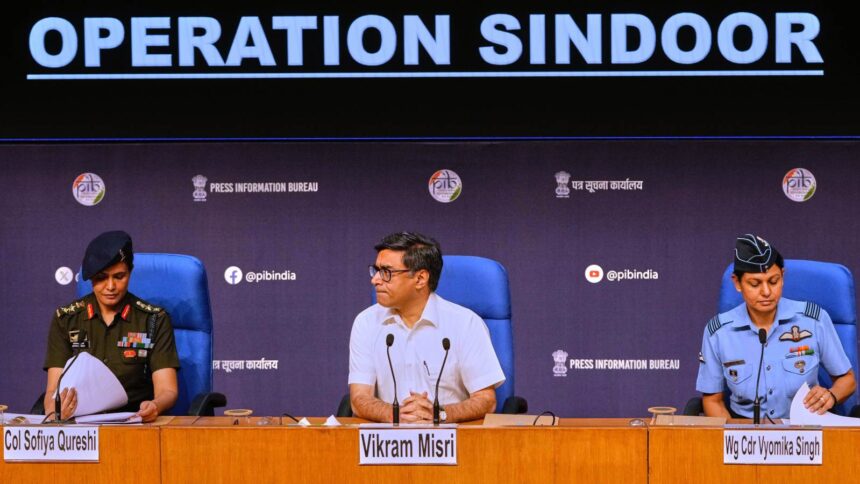On Wednesday morning, as Foreign Secretary Vikram Misri took his seat at the National Media Centre in the heart of the capital to brief the media on India’s retaliation to the Pahalgam terror attack, he was accompanied by two unfamiliar faces – Wing Commander Vyomika Singh of the Indian Air Force and Colonel Sophiya Qureshi of the Indian Army. The significance of the Union government choosing two women officers from the armed forces to disclose details of ‘Operation Sindoor’ was not lost on anyone.
During the briefing, Qureshi addressed the media in Hindi, explaining the selected terrorist targets destroyed through precision attacks, while Singh followed with the same information in English. The briefing lasted 25 minutes – coincidentally, the same duration as ‘Operation Sindoor’ itself.
In contrast, on September 29, 2016, after the surgical strikes carried out in response to the Uri attack, the Indian government had chosen Lieutenant General Ranbir Singh, then Director General of Military Operations (DGMO) of the Indian Army, to brief the media. Similarly, after the airstrikes on February 26, 2019, the responsibility of briefing the media was given to then Foreign Secretary Vijay Gokhale.
So, who are the two women that the Modi government chose to disclose details of ‘Operation Sindoor’?
An officer of the Army’s Signal Corps, the 44-year-old whose achievements were highlighted by the Supreme Court in its landmark 2020 judgment on gender parity in the Army’s top positions. The judgment dismissed the government’s arguments against granting women command appointments and specifically acknowledged the accomplishments of these 11 female officers. “Women officers of the Indian Army have brought laurels to the force,” the Supreme Court noted, and Qureshi was among those recognized.
Colonel Qureshi holds the rare distinction of being the first woman officer to lead an Indian Army contingent in a major multinational military exercise. In February and March of 2016, then a 35-year-old Lieutenant Colonel, she led the Indian Army’s 40-member contingent in a multinational exercise.
The Multinational Field Training Exercise (FTX) – Exercise FORCE 18 involved ASEAN Plus countries and was the largest ground forces exercise ever conducted on Indian soil at the time. It was based on the themes of ‘Humanitarian Mine Action’ and ‘Peacekeeping Operations’.
Colonel Qureshi also served in the United Nations Peacekeeping Operation in Congo in 2006 and has been associated with peacekeeping operations for over six years. Her leadership in the exercise came after being selected from a pool of peacekeeping trainers. When asked about leading the contingent, she said, “I feel proud, of course.” Her message to young women in the armed forces was: “Work hard for the country and make everyone proud.”
During that time, the Army Commander of the Southern Command, the late , who later became the Army Chief and India’s first Chief of Defence Staff, praised her. He remarked, “In the Army, we believe in equal opportunity and equal responsibility. There is no difference between male and female officers. She was chosen not because she is a woman but because she has the abilities and leadership qualities to shoulder the responsibility.”
Colonel Qureshi holds a postgraduate degree in Biochemistry. She hails from Vadodara, Gujarat, and comes from a family with a strong military tradition—her grandfather served in the Army, and her father was an Army religious teacher. She joined the Indian Army through the Officers Training Academy in 1999 and is married to Major Tajuddin Qureshi of the Mechanised Infantry.
A helicopter pilot in the Air Force, Singh was commissioned into the IAF on December 18, 2004, as part of the 21st Short Service Commission (Women) Flying Pilot Course and was promoted to the rank of Wing Commander on December 18, 2017. Specializing in helicopter operations, she has logged over 2,500 flying hours on Chetak and Cheetah helicopters. In 2021, she participated in a tri-services all-women mountaineering expedition to Mt. Manirang, one of the highest peaks of Himachal Pradesh, nestled at the border of Kinnaur & Spiti districts, demonstrating her resilience and dedication.
Ritika joined The Indian Express in 2015. Previously, she was part of the political bureau at The Economic Times, India’s largest financial daily. Her journalism career began in Kolkata, her birthplace, with the Hindustan Times in 2006 as an intern, before moving to Delhi in 2007. Since then, she has been reporting from the capital on politics, education, social sectors, and the Election Commission of India.








